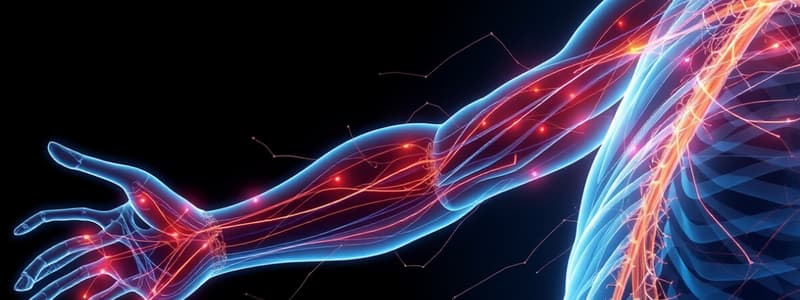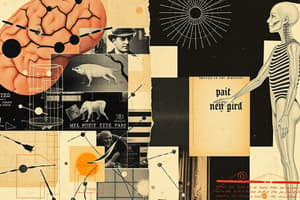Podcast
Questions and Answers
What is the primary role of somatic motor neurons in skeletal muscle reflexes?
What is the primary role of somatic motor neurons in skeletal muscle reflexes?
- To inhibit muscle contraction
- To provide excitatory input causing muscle contraction (correct)
- To maintain muscle relaxation
- To integrate sensory signals from the CNS
What prevents relaxation of skeletal muscle during reflex actions?
What prevents relaxation of skeletal muscle during reflex actions?
- Proprioceptors located in joint capsules
- The presence of somatic motor neuron stimulation (correct)
- Sensory neuron feedback to the spinal cord
- Active inhibitory neurons acting on the effector
In a monosynaptic reflex, how many synapses are involved between the afferent and efferent neurons?
In a monosynaptic reflex, how many synapses are involved between the afferent and efferent neurons?
- One synapse (correct)
- Three synapses
- Two synapses
- Four synapses
Which type of neuron is responsible for inhibiting the activity of somatic motor neurons?
Which type of neuron is responsible for inhibiting the activity of somatic motor neurons?
Where are proprioceptors primarily located?
Where are proprioceptors primarily located?
What role does the spinal cord play in the reflex arc?
What role does the spinal cord play in the reflex arc?
What would be the most direct effect of an absent excitatory input from somatic motor neurons?
What would be the most direct effect of an absent excitatory input from somatic motor neurons?
Which neurons carry the output signal from the central nervous system to the skeletal muscle during reflex actions?
Which neurons carry the output signal from the central nervous system to the skeletal muscle during reflex actions?
Which part of the brain is primarily responsible for the integration of autonomic reflexes?
Which part of the brain is primarily responsible for the integration of autonomic reflexes?
Which statement correctly describes skeletal muscle reflexes?
Which statement correctly describes skeletal muscle reflexes?
What type of control is described by continuous activity in an effector, such as blood vessels?
What type of control is described by continuous activity in an effector, such as blood vessels?
How does the autonomic system manage reflex responses?
How does the autonomic system manage reflex responses?
What is a characteristic of a monosynaptic reflex?
What is a characteristic of a monosynaptic reflex?
What physiological response is linked to strong emotional states?
What physiological response is linked to strong emotional states?
What happens when excitation of somatic motor neurons ceases?
What happens when excitation of somatic motor neurons ceases?
Which reflexive action is classified as a spinal reflex?
Which reflexive action is classified as a spinal reflex?
What type of reflexes are classified as being polysynaptic?
What type of reflexes are classified as being polysynaptic?
Which components are found in the pathway of an autonomic reflex?
Which components are found in the pathway of an autonomic reflex?
Which statement correctly describes the function of the integrating center in an autonomic reflex?
Which statement correctly describes the function of the integrating center in an autonomic reflex?
What is the role of preganglionic autonomic neurons in the reflex pathway?
What is the role of preganglionic autonomic neurons in the reflex pathway?
In the context of reflexes, which type of reflex is recognized for directly involving skeletal muscles?
In the context of reflexes, which type of reflex is recognized for directly involving skeletal muscles?
Which of the following best defines visceral reflexes?
Which of the following best defines visceral reflexes?
What distinguishes autonomic reflexes from other types of reflexes?
What distinguishes autonomic reflexes from other types of reflexes?
Which part of the central nervous system is primarily involved in processing autonomic reflexes?
Which part of the central nervous system is primarily involved in processing autonomic reflexes?
Study Notes
Skeletal Muscle Reflexes
- Somatic motor neurons cause contraction of skeletal muscle; there are no inhibitory neurons for relaxation.
- Relaxation occurs when there is an absence of excitatory input by somatic motor neurons.
- Inhibitory interneurons within the central nervous system (CNS) can inhibit somatic motor neuron activity.
- Proprioceptors located in skeletal muscles, joint capsules, and ligaments provide sensory input to the CNS.
Reflex Arc Components
- Reflex arcs consist of a sensory neuron, integrating center in the spinal cord, and an efferent neuron (alpha motor neuron).
- A monosynaptic reflex involves a single synapse between afferent and efferent neurons, facilitating fast responses.
- Spinal reflexes can operate without brain input but may be modulated by the CNS (e.g., potty training represents a learned reflex).
CNS Integration Centers
- Reflexes are integrated in the hypothalamus, thalamus, and brain stem, which control various autonomic functions.
- Emotion-related reflexes, such as piloerection in response to fear, illustrate the connection between emotional stimuli and physiological responses.
Tonic Activity and Control
- Tonic control refers to continuous activity from a stream of action potentials, especially in regulating blood vessel tone.
- Antagonistic control involves balancing opposing signals to maintain homeostasis in autonomic functions.
Autonomic Reflexes
- All autonomic reflexes are polysynaptic, involving multiple synapses, including at least one in the CNS and one in a ganglion.
- Known as visceral reflexes, autonomic reflexes control functions like temperature regulation and water balance, highlighting their role in maintaining homeostasis.
Summary of Key Concepts
- Skeletal muscle reflexes primarily depend on somatic motor neurons that induce contraction.
- Monosynaptic reflexes involve quick reactions with minimal synaptic delay.
- The CNS integrates sensory information and coordinates responses through various structures.
- Autonomic reflexes are more complex, engaging multiple synapses and performing critical roles in internal processes.
Studying That Suits You
Use AI to generate personalized quizzes and flashcards to suit your learning preferences.
Related Documents
Description
Explore the intricate details of skeletal muscle reflexes and the components of reflex arcs in this quiz. Understand how somatic motor neurons function, the role of proprioceptors, and the integration of reflexes in the central nervous system. Test your knowledge on monosynaptic reflexes and their responses.




